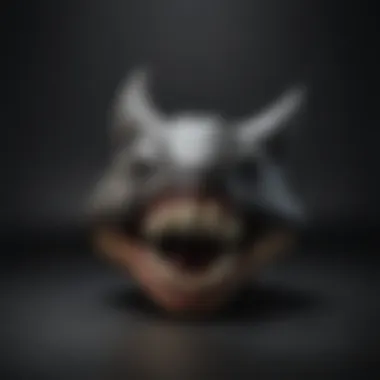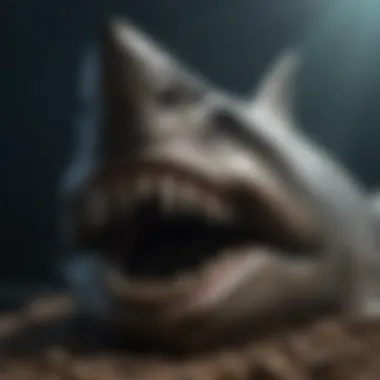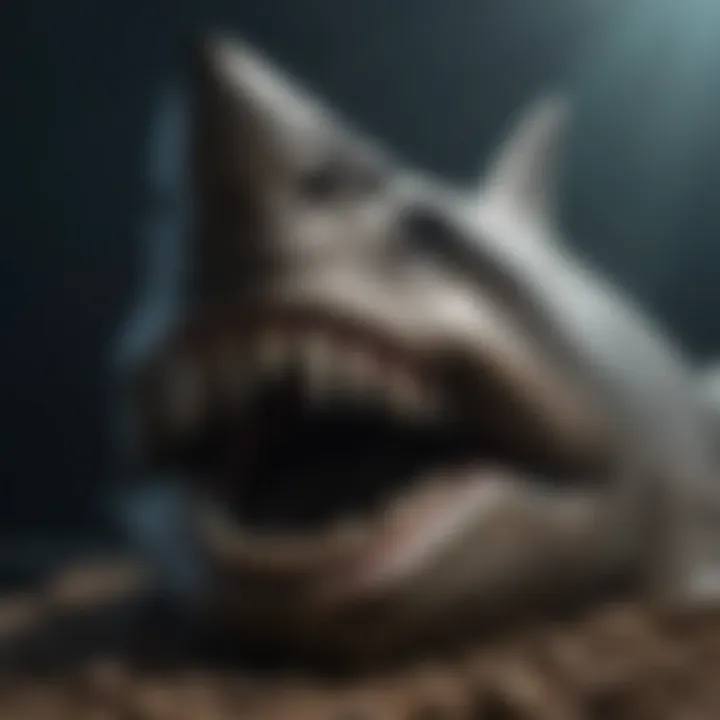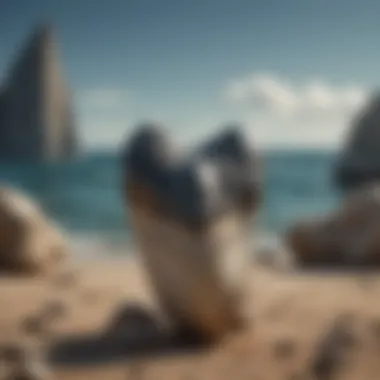Understanding the Cost of a Megalodon Tooth


Intro
The megalodon, a prehistoric shark, is a fascinating subject for collectors and enthusiasts alike. Its teeth are some of the most sought-after items in the fossil market. Understanding the cost of these teeth requires delving into various factors that determine their value. This article will provide an informed perspective on what influences the pricing of megalodon teeth, including size, rarity, condition, and authenticity. Additionally, practical advice for buyers and insights into recent market trends will enhance your knowledge, making you a more informed collector.
History and Origins
Overview of Collectibles, Rocks, and Fossils
Collecting fossils has long been a respected hobby. Fossils like the megalodon tooth open a window into Earth’s distant past. They are remnants of a living creature that dominated the oceans millions of years ago. The allure of owning a piece of this history drives many to seek these teeth passionately. Collectible items often gain sentimental and monetary value, and megalodon teeth are no exception.
Historical Significance and Cultural Impact
Megalodon teeth have captured popular imagination for decades. They often appear in literature, cinema, and art, enhancing their cultural relevance. Early collectors and scientists recognized their importance, contributing to paleontological studies. Therefore, the significance goes beyond mere collection; it embodies a connection to life forms that once thrived. This history adds another layer of value to megalodon teeth, making them more than just collectibles.
Identification and Classification
Guide to Identifying Rocks and Fossils
When it comes to megalodon teeth, identification is crucial. Genuine teeth possess certain characteristics, such as distinct serrations and a specific shape. Color also varies, influenced by factors such as mineral content in the surrounding soil. Recognizing these traits helps distinguish authentic teeth from replicas or lower-quality finds.
Common Types and Variations
Not all megalodon teeth are created equal. Factors like size and condition lead to various categories. Common variations include:
- Size: Larger teeth are generally more valuable.
- Color: Certain hues like deep black or reddish-brown can command higher prices.
- Condition: Teeth with minimal wear or breakage are most prized.
Understanding these characteristics aids in making informed purchases in an ever-evolving market.
Intro to Megalodon Teeth
Megalodon teeth hold a unique place in the realm of paleontology and collecting. As remnants of one of the largest predatory fish in history, these teeth offer not only a glimpse into evolutionary biology but also serve as highly sought after collectibles. Understanding the significance of megalodon teeth is essential for anyone interested in the fossil market. Collectors value these teeth for their size, aesthetic appeal, and historical context. The influence of various factors on their market price cannot be overstated.
Geological Significance
The geological significance of megalodon teeth lies in their ability to provide information about past marine environments. These fossils date back to the Cenozoic Era, approximately 23 to 3.6 million years ago. Their locations often correlate with regions that were once under ocean water, showcasing the geological changes our planet has undergone. Additionally, studying these teeth provides insights into the habitats and behaviors of these massive creatures. Fossil distribution can inform scientists about paleoecology and ancient ecosystems.
Fossilization Process
The fossilization process of megalodon teeth is complex and essential for understanding their value. Unlike many organic materials that decompose, the hard enamel of megalodon teeth can survive a variety of environmental conditions. This durability is partly due to the tooth's crystalline structure. When these teeth are buried in sediment over time, mineral exchange occurs, contributing to fossilization. Factors such as sediment type, groundwater chemistry, and time influence the final appearance and condition of these teeth. Understanding this process can help collectors assess the quality of specimens, impacting their value in the market.
Factors Influencing the Cost


Size of the Tooth
The size of a megalodon tooth is often the first element to consider. Larger teeth command higher prices due to their impressive nature and rarity. A complete megalodon tooth can reach lengths of up to 7 inches or more. However, even smaller specimens can still hold value. Collectors usually seek out teeth that are not only large but also well-preserved. Alongside size, the jaw size of megalodon itself adds to the excitement of ownership. It's understood that bigger teeth are more challenging to find, leading to an increase in demand, which raises the price.
Condition and Quality
Condition and quality are paramount when evaluating megalodon teeth. Factors such as chips, scratches, and discoloration detract from the overall appeal. Collectors prioritize teeth that are intact and exhibit minimal wear. A tooth that has undergone some restoration may still be of interest, but it usually fetches a lower price. Moreover, the overall aesthetics matter; a gloss finish or a natural polished look can elevate the value significantly. Keeping teeth in top shape then becomes a task for collectors who aim to maintain value over time.
Authenticity and Provenance
In the world of collectibles, authenticity cannot be overstated. A genuine megalodon tooth has undeniable value, while replicas or dubious sources can lead to poor investment decisions. Provenance matters greatly in establishing authenticity. A tooth with clear documentation of its origin or past ownership history is more desirable. Collectors typically look for certificates of authenticity or knowledgeable sellers to ensure they are making a legitimate purchase. Trust is vital in the market, making verification an essential step in any acquisition.
Rarity and Collectibility
Rarity plays a significant role in determining the cost of megalodon teeth. It is not merely about availability; certain variations, such as color or specific growth patterns, can make a tooth more unique. Collectible teeth are often those that exhibit unusual features. Additionally, teeth sourced from specific regions can be highly sought after. The growth of an enthusiast community adds to the narratives surrounding megalodon teeth. As more collectors emerge, the demand for rare pieces can push prices even higher, leading to a vibrant trading environment.
Market Trends
Understanding market trends is essential for anyone interested in the cost of megalodon teeth. Trends offer insights into how demand and supply shape prices. Collectors often look to market trends to make informed purchasing decisions. This section explains several key factors influencing prices in the megalodon tooth market today.
Current Pricing Benchmarks
The current price of megalodon teeth varies significantly based on several criteria. Size is a major influencer; larger teeth command higher prices. For example, teeth measuring over six inches can sell for thousands of dollars. Factors such as condition, quality, and clarity also play a crucial role.
To paint a clearer picture:
- Small teeth (under three inches) may range from $20 to $100.
- Medium teeth (three to six inches) can range from $100 to $1,000.
- Large teeth (over six inches) typically fetch $1,000 or more; some premium specimens might even exceed $10,000.
The dental structure also matters. Well-preserved teeth with a shine and minimal damage attract higher prices. Sellers and buyers alike should closely examine these characteristics during transactions.
Historical Price Fluctuations
Over the years, prices of megalodon teeth have shown fluctuations influenced by external factors. Demand in the collector community has not always been constant. Historical data indicates several spikes in prices. Economic conditions, fossil discovery rates, and relevant trends in archeology often caused these fluctuations.
- 1990s: Prices were relatively stable, with large teeth often priced around $300 to $500.
- 2000s: A surge in popularity among collectors led to increased prices, with some exceptional teeth reaching $2,000.
- 2010s to Present: The prices peaked due to intensified interest and limited supply. Now, unique finds can exceed $10,000, reshaping the market.
Such trends emphasize the importance of researching market behavior. Collectors should remain vigilant to changes to decide when to buy or sell.
"Market trends shape not only the current value but also the future potential of megalodon teeth as collectibles."
Investors and collectors can use this knowledge to navigate future purchases. Having a good understanding of past price changes can help in anticipating future trends in this niche market.


Buying Megalodon Teeth
Purchasing megalodon teeth can be an exhilarating and rewarding experience for collectors and enthusiasts alike. The fascination with these ancient marine predators drives a market that is rich with history and intrigue. As a potential buyer, understanding the nuances of acquiring such a unique item is essential. Various factors come into play, including considerations about where to buy, how to evaluate sellers, and effective negotiation strategies that can help secure the best price.
Where to Buy
When it comes to sourcing megalodon teeth, numerous avenues exist. The options include:
- Online Marketplaces: Websites like eBay or Etsy often feature listings from both private sellers and established retailers. While this offers convenience, due diligence is necessary to ensure authenticity.
- Specialty Fossil Stores: Stores that focus on fossils provide more assurance of quality and authenticity. These shops usually have a knowledgeable staff that can answer specific questions about the items.
- Fossil Shows and Expos: Attending these events can provide an opportunity not only to purchase but also to interact with some of the most reputable sellers in the industry. Such gatherings often feature a wide variety of fossils, including megalodon teeth, which allows for comparison.
- Collector Networks: Engaging with fellow collectors can open doors to private sales or trades that are not publicly advertised.
Evaluating Sellers
Determining the legitimacy of a seller is crucial when buying megalodon teeth. Here are a few important steps to take:
- Research Seller Reputation: Look for reviews or feedback from previous buyers. Websites that allow user ratings can give insights into reliability.
- Ask Questions: Do not hesitate to inquire about the tooth's provenance and how the seller acquired it. A reputable seller will be willing and able to provide detailed information.
- Check for Guarantees: Some sellers offer guarantees regarding authenticity or return policies. This can provide additional peace of mind.
- Examine Photographs: Look at multiple high-resolution images of the tooth. Pay attention to details that might indicate wear or alterations.
"A trusted seller will be transparent about the history of the megalodon tooth they are selling."
Negotiating the Price
Negotiating the price of a megalodon tooth can significantly impact your investment. Effective negotiation often hinges on a few key points:
- Know the Market Value: Familiarize yourself with the current pricing trends for megalodon teeth based on size, condition, and rarity. This knowledge provides a solid foundation for your negotiation.
- Set Your Budget: Understand your maximum spending limit before entering negotiations. This will help prevent overspending out of impulse.
- Be Polite but Firm: Approach negotiations respectfully. Don't hesitate to express your price, but be open to compromise.
- Timing Matters: If there is a lack of interest in a specific tooth, the seller may be more inclined to negotiate. Conversely, during peak demand, you might find the seller less willing to budge.
Aspects of Care and Maintenance
The importance of maintaining megalodon teeth cannot be understated. As unique fossils, they carry not just historical significance but also a high monetary value. Proper care ensures that these items retain their integrity over time. Collectors should be vigilant in their approach, as neglect can lead to deterioration, affecting both appearance and worth.
Preservation Techniques
Preserving a megalodon tooth involves several critical techniques. Here are the main strategies that help protect these treasures of the past:
- Avoiding Direct Sunlight: Ultraviolet rays can cause fading and damage to the surface of the tooth. It is best to display them in darker, cooler areas.
- Temperature and Humidity Control: Keeping the environment stable is essential. Too much humidity can lead to mold growth, while extreme dryness may cause cracking. The ideal conditions typically involve temperature stability between 60-75°F and humidity around 40-60%.
- Routine Cleaning: While megalodon teeth are durable, gentle cleaning is necessary to remove dust. Using a soft brush or a damp cloth can effectively clean the tooth without scratching its surface. Avoid harsh chemicals as they can cause damage.
- Proper Storage: For those not on display, use padded boxes or acid-free materials for storage. These considerations will minimize risks of scratches or other physical harm.
These preservation practices not only enhance the longevity of the speciemn but also enhance its value in the collection.
Display Considerations
When it comes to displaying megalodon teeth, aesthetics and protection go hand in hand. Here are factors to consider:
- Display Case Safety: Utilizing a secure display case can prevent accidental damage from falling or improper handling. Glass cases provide both protection and visibility, allowing collectors to showcase their prized possession.
- Use of Stands: Custom stands designed for megalodon teeth can boost their visual appeal. They allow for the teeth to be viewed from multiple angles, enhancing their display quality.
- Lighting: Strategic lighting can highlight the unique features of the tooth without causing damage. Soft LED lights are ideal as they emit less heat compared to traditional bulbs.
- Location: Place the display in a stable environment, away from high-traffic areas that could result in accidental bumps or falls. Keeping the piece in a well-ventilated area also aids in maintaining environmental conditions.


By giving careful thought to preservation and display, collectors can ensure that their megalodon teeth not only stay in excellent condition but also act as striking focal points in their collections.
Proper care and maintenance can add to the investment value of a megalodon tooth, making it a worthy pursuit for serious collectors.
The Role of Community and Collectors
The community surrounding megalodon teeth is essential in shaping the market and providing collectors with invaluable resources. Collectors often share their findings and knowledge through various platforms, enhancing the collective understanding of these remarkable fossils. Engaging with this community can offer insights into pricing, authenticity, and preservation that can significantly benefit both novice and experienced collectors.
When collectors connect, they create a space of shared enthusiasm and expertise. Information exchange can occur through discussion forums such as Reddit or specialized Facebook groups dedicated to fossil collecting. Here, members post pictures of their megalodon tooth collections, discuss recent purchases, and offer feedback about sellers. This direct communication fosters a sense of belonging and builds valuable networks that can lead to successful transactions.
Networking in this way also helps in evaluating the value of specific megalodon teeth based on shared experiences. Collectors might highlight features that determine cost, such as size, condition, and rarity. By obtaining a better understanding of the market through these channels, collectors can make informed decisions. Such a connection is not just about buying and selling; it is about building trust.
Networking with Other Collectors
The act of networking within the megalodon tooth collector community can significantly enrich one's collecting experience. By interacting with others who share the same passion, collectors can exchange tips, techniques, and tools that are vital in evaluating the authenticity and condition of a tooth.
"Networking is not just for big deals; it's about learning and growing in the field."
Building relationships with fellow collectors opens up opportunities for collaborations. For example, some collectors might organize trips to fossil sites, enabling others to hunt for megalodon teeth together. This collaboration can also lead to shared finds or trade agreements, further enhancing the collection while fostering camaraderie.
Additionally, through networking, collectors have a chance to attend events, such as fossil fairs or conventions, where they can meet renowned experts in the field. Such interactions can prove valuable, as engaging directly with experts can lead to deeper understanding and opportunities to acquire exceptional specimens.
Learning Opportunities
The opportunities for learning within the megalodon tooth community are vast. Engaging with experienced collectors can provide newcomers with essential knowledge about different aspects of collecting. One can learn about the geological contexts in which megalodon teeth are found, factors that impact their value, and preservation techniques that ensure longevity.
Online resources such as Wikipedia or Britannica offer substantial information, but there is no substitute for real-world experience and anecdotes shared by other collectors. For example, discovering how different collectors care for their specimens can lead to new preservation methods, which ultimately enhance the quality and appearance of a collection.
Forums and social media groups frequently host discussions around topics such as market trends, pricing history, or tips on negotiation tactics. These platforms serve as an educational resource, where expertise can be shared on detecting fakes. Such knowledge is crucial, as the market for megalodon teeth has seen an increase in replicas or misrepresented items.
In summary, networking with other collectors and exploring learning opportunities can significantly enhance one’s authority and confidence in the megalodon teeth collectible space. The community not only fosters growth on an individual level, but it also strengthens the market through informed participation and shared experiences.
Ending
When collectors evaluate megalodon teeth, they must consider several elements that affect the price. Key factors include size, condition, authenticity, and rarity. Each element contributes uniquely to the overall cost. For instance, larger, well-preserved teeth tend to command higher prices, while authenticated specimens from reputable sources can significantly enhance their value.
Buyers should also pay attention to market trends. Prices fluctuate based on demand and availability, impacting investment strategies. By understanding current pricing benchmarks, collectors can better navigate their purchasing options and avoid overpaying.
Mentioning communities and collectors, building connections can enhance a collector’s knowledge and provide access to better deals. Networking acts as a resource for learning about market changes and helps form a supporting group where collectors share insights and experiences. Being well-informed and connected can turn a simple hobby into a rewarding investment venture.
In summary, knowledgeable insights into the cost of megalodon teeth benefits potential buyers. This understanding empowers them to make strategic investments while appreciating the unique history and scientific significance these fossils represent.
Final Thoughts on Investment
Investing in megalodon teeth can be lucrative but requires careful consideration. Potential buyers should approach their purchases with a clear grasp of what they value the most. Whether seeking aesthetic appeal, investment potential, or scientific interest, each collector's journey is personal.
Quality is paramount, so focus on obtaining the best possible specimens. Engage with reputable sellers and ensure thorough investigation into the item's provenance. Being part of a collector community can provide ongoing education and support in this journey. Ultimately, a well-considered investment not only enriches a collector's collection but also connects them to the vast history of marine life.



